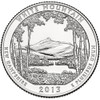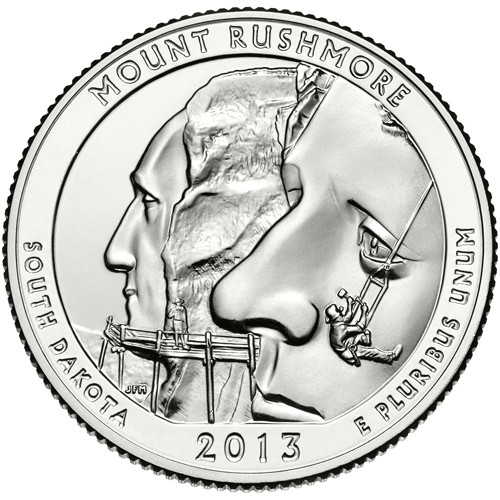
# CNNHWM25D - 2013 New Hampshire White Mt Natl Park Quarter, D Mint
White Mountain National Forest Quarter
Denver Mint
Issue Date: January 28, 2013
Issue Quantity: 107,600,000
White Mountain National Forest Quarter Design Elements: Mt. Chocorua (part of the Sandwich Range) framed by birch trees
Some of the earliest known white pioneers in the White Mountains were Darby Field and John Josselyn. They were the first two men to explore and write extensively about the area. As they and other early explorers spread the word about the towering mountains and lush forests, people from as far away as Great Britain turned their attention to the White Mountains.
As artists and writers found their way to the White Mountains, word spread across the country of their beauty and scenery. With this, businessmen saw new opportunities in tourism. Grand hotels were constructed at the summits and along notches, and railroads and stagecoach roads were built to make easier access.
In 1875, the modern logging industry boomed in the White Mountains. Decades of unregulated logging by private timber companies in the area became a serious issue, leaving the landscape susceptible to fires and floods. With these issues, as well as the expanding conservation movement in mind, local citizens were driven to take action.
After several years of intense lobbying and pressure from the public, Senator John Weeks took action. He introduced the Weeks Act, which was approved by Congress on March 1, 1911. The new legislation authorized the Secretary of Agriculture to “Examine, locate, and recommend for purchase ... such lands within the watersheds of navigable streams as ... may be necessary to the regulation of flow of navigable streams.”
On May 16, 1918, Woodrow Wilson officially created the White Mountain National Forest. Since that time, several more tracts of land have been added and work has been done to preserve the historic sites, buildings, and natural resources.
White Mountain National Forest Quarter
Denver Mint
Issue Date: January 28, 2013
Issue Quantity: 107,600,000
White Mountain National Forest Quarter Design Elements: Mt. Chocorua (part of the Sandwich Range) framed by birch trees
Some of the earliest known white pioneers in the White Mountains were Darby Field and John Josselyn. They were the first two men to explore and write extensively about the area. As they and other early explorers spread the word about the towering mountains and lush forests, people from as far away as Great Britain turned their attention to the White Mountains.
As artists and writers found their way to the White Mountains, word spread across the country of their beauty and scenery. With this, businessmen saw new opportunities in tourism. Grand hotels were constructed at the summits and along notches, and railroads and stagecoach roads were built to make easier access.
In 1875, the modern logging industry boomed in the White Mountains. Decades of unregulated logging by private timber companies in the area became a serious issue, leaving the landscape susceptible to fires and floods. With these issues, as well as the expanding conservation movement in mind, local citizens were driven to take action.
After several years of intense lobbying and pressure from the public, Senator John Weeks took action. He introduced the Weeks Act, which was approved by Congress on March 1, 1911. The new legislation authorized the Secretary of Agriculture to “Examine, locate, and recommend for purchase ... such lands within the watersheds of navigable streams as ... may be necessary to the regulation of flow of navigable streams.”
On May 16, 1918, Woodrow Wilson officially created the White Mountain National Forest. Since that time, several more tracts of land have been added and work has been done to preserve the historic sites, buildings, and natural resources.







